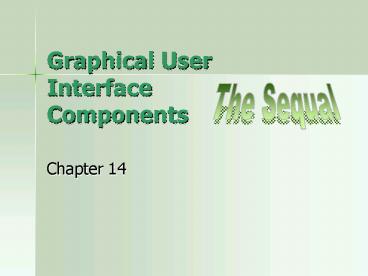Graphical User Interface Components - PowerPoint PPT Presentation
1 / 21
Title:
Graphical User Interface Components
Description:
Pop up menus. Look and feel options. 3. JTextArea. Area for manipulating multiple lines of text ... Aggregate a set of GUI components. Create dedicated drawing areas ... – PowerPoint PPT presentation
Number of Views:93
Avg rating:3.0/5.0
Title: Graphical User Interface Components
1
Graphical User Interface Components
The Sequal
- Chapter 14
2
What You Will Learn
- Text Areas
- Sliders
- Menus
- With frames
- Pop up menus
- Look and feel options
3
JTextArea
- Area for manipulating multiple lines of text
- Extends JTextComponent
- Inherits from that class
- View Figure 14.1
- Note
- Creation of box
- Creation of two JTextArea objects
- Copy of marked text to other text area
4
Subclass of JPanel
- A JPanel can
- Aggregate a set of GUI components
- Create dedicated drawing areas
- Create areas that receive mouse events
- Subclass of a JPanel should
- Override method paintComponent
- Call the superclass version as first statement
- Note the customized JPanel subclass, Figure 14.2
5
Demonstration of Customized JPanel
- Now view Figure 14.3
- Note
- Declaration, instantiation of the CustomPanel
- Method draw used in actionPerformed methods
6
Another Customized JPanel Class
- Possible for the (sub)class to handle its own
events - Note SelfContainedPanel class, Figure 14.4
- This class has
- Mouse activity handlers
- Preferred dimension specified
- Call to paintComponent method
- Figure 14.5 uses this customized subclass
7
JSliders
- Enable users to select from range of integer
values - Features
- Tick marks (major and minor)
- Snap-to ticks
- Orientation (horizontal and vertical)
thumb
8
JSliders
- JPanel subclass for drawing circles, Figure 14.7
- JSlider used to control size of a circle graphic,
Figure 14.8 - Note
- Slider declaration, implementation
- Registration of listener for the slider
9
Using Menus with Frames
- Allows for performing actions with cluttering GUI
- Contained by menu bar JMenuBar
- Comprised of menu items MenuItem
- Note Figure 14.9
- Declares menu items
- Populates the menus
- Specifies actions for menu choices
10
JPopupMenu
- Menus that are context-sensitive
- Right click and popup menu appears
- In Swing, use JPopupMenu
- Provide options specific to component
- Popup trigger event occurs when object right
mouse clicked - Demonstration of JPopupMenu shown in Figure 14.10
11
Pluggable Look-and-Feel
- Recall that Java is designed to run on variety of
platforms - GUI components on a Mac, look different from
those on a PC or on a UNIX platform - Look-and-Feel capability
- Java program on a particular platform looks like
other programs on the same platform - Also possible to specify the look-and-feel of a
Swing GUI
12
Pluggable Look-and-Feel
- Figure 14.11 demonstrates how to change the
appearance - Note use of UIManager methods
13
JDesktopPane and JInternalFrame
- Multiple document interface
- Main (parent) window
- Child windows
- View Figure 14.12 which demonstrates this
- Note
- Declaration, instantiation of JDesktopPane object
- Choosing and painting of the icons
14
JTabbedPane
- Arranges GUI components into layers
- One layer visible at a time
- Access each layer via a tab
- View tab demo program, Figure 14.13
- Note
- declaration of tabbed panes
15
Layout Managers
- BoxLayout arranges GUI components
- Horizontally along x-axis
- Vertically along y-axis
16
BoxLayout
- Demonstrated in Figure 14.15
- Also uses the tabs
- Offers several different options for laying out
three JButtons - Note
- Creation of boxes
- Adding of buttons
17
GridBagLayout Layout Manager
- Flexible GridBagLayout
- Components can vary in size
- Components can occupy multiple rows and columns
- Components can be added in any order
- Uses GridBagConstraints
- Specifies how component is placed in
GridBagLayout
18
GridBagLayout Layout Manager
- GridBagConstraints fields
19
GridBagLayout Layout Manager
- Designing a GUI to use the GridBagLayout
- Program for this layout demonstrated in Figure
14.19
Column
0
1
2
0
1
Row
2
3
20
GridBagLayout Layout Manager
- Variation of GridBagLayout does not use gridx and
gridy - Use constants RELATIVE and REMAINDER
- RELATIVE
- Specifies next-to-last component placement in row
or column - Component placed next to one previously added
- REMAINDER
- Specifies component as last component in row or
column
21
GridBagLayout Layout Manager
- Use of constraints demonstrated inFigure 14.20
- Note
- Setting constraint weights
- Setting grid width
- Adding buttons
- The addComponent method































